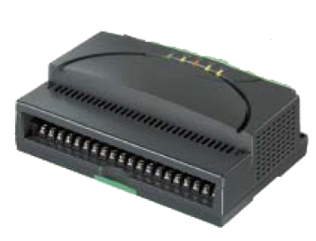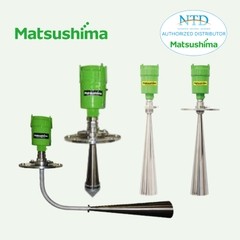
RZUS-U9/MSR PC RECORDER (universal input, 12 points; isolated; bus-powered USB)
RZUS-U9/MSR
PC Recorders RZUS Series
-
PC RECORDER
- (universal input, 12 points; isolated; bus-powered USB)
Functions & Features
• Industrial recorder on PC
• 12-point universal inputs
• Channel-to-channel isolation
• Trigger input and alarm contact output
• Filtering protection against 50/60 Hz noise
• USB and RS-485 interface
• No need of dedicated power source
MODEL: RZUS-U9T/MSR
ORDERING INFORMATION
• Code number: RZUS-U9T/MSR
FIELD TERMINAL TYPE
T: M3 screw terminals
OPTIONS
PC Recorder Software Package (must be specified)
/MSR: With
RELATED PRODUCTS
• Resistor module (model: REM3-250)
Though the REM3 is designed to be mounted directly to this model, we recommend that it be attached to a separate terminal board in order to eliminate its heat conduction to affect the cold junction compensation and the overall measuring accuracy of this model.
• RZXS configurator software (model: RZMSCFG)
Downloadable at our web site.
A dedicated cable is required to connect the module to the PC. Please refer to the internet software download site or the users manual for the PC configurator for applicable cable types.
PACKAGE INCLUDES...
• PC Recorder Software CD
• USB cable (1 m or 3.3 ft)
GENERAL SPECIFICATIONS
Connection
USB: USB type B connector, female
RS-485: Euro type connector terminal
(Applicable wire size: 0.2 – 2.5 mm2 (AWG24 – 12), stripped
length 7 mm)
I/O: M3 screw terminals (torque: 0.6N·m)
Grounding: M4 screw terminal (torque: 1.2N·m)
PC Configurator: Miniature jack, RS-232-C level
Screw terminal: Nickel-plated steel
Housing material: Flame-resistant resin (gray)
Isolation: Input 1 to input 2 to input 3 to input 4 to input 5 to input 6 to input 7 to input 8 to input 9 to input 10 to input 11 to input 12 to trigger input to alarm output to USB or RS-485 or configurator jack to ground
Zero/span adjustments: Available with PC Configurator Software for all types of inputs.
Burnout for T/C and RTD input: Upscale, Downscale or No burnout selectable
Select ‘No Burnout’ to minimize the measuring errors caused by the sensor/wire resistance and the burnout sensing current.
With RTD input, the signal may go transiently to the opposite direction from the burnout setting.
With DC/potentiometer input, the burnout setting is ignored and the burnout sensing current is cancelled.
In order to specify burnout actions to individual channels, use PC Configurator Software.
Wire resistance compensation for RTD input: Field calibration for 3-wire (or 2-wire) RTD available with PC Configurator Software.
Cold junction compensation (CJC) for T/C input: CJC can be enabled or disabled. Reference temperature is measured at the internal sensor by factory setting.
In order to specify cold junction compensation to individual channels, use PC Configurator Software.
Temperature measured at another channel of this model can be specified as the reference point by using PC Configurator Software. This is beneficial to reduce compensation wires’ cost when there are many temperature points in remote locations.
Install a relaying terminal board near the sensors and use ordinary copper wires between the board and this model, and assign one channel to measure temperature at the terminal board as the reference.
Operating mode setting: Rotary switch; burnout type, cold junction compensation, line noise frequency, software filter, A/D conversion mode, service channel numbers setting available
Line noise filter: NMNR ratio to the line frequency and its harmonic contents can be optimized. Factory set to 50/60 Hz mode for use with both frequencies. Select either frequency for the most effective result.
Programmable first order lag filter: Time constant selectable with PC Configurator Software.
The use of this filter is disabled at the factory shipment.
With the large time constant setting, measured signals during the warm-up immediately after the power is turned on may affect the signals for a long time period.
A/D conversion mode: Fast, Medium or Slow selectable with PC Configurator Software.
With Slow setting, data fluctuations are minimized with limited sampling time (speed).
With Fast setting, sampling time (speed) can be high though data fluctuations increase.
Node address setting: Rotary switch; 1 – F (15 nodes)
Indicator LEDs: Five (5) LEDs indicate the module’s operating conditions.
Service channel numbers: 12 channels (ch.1 thr. 12) or 6 channels (ch.1 thr. 6) are selectable with PC Configurator Software. Factory set to 12 channels.
COMMUNICATION
Baud rate: 38.4 kbps
Communication: Half-duplex, asynchronous, no procedure
Protocol: Modbus RTU
■ RS-485
Standard: Conforms to TIA/EIA-485-A
Transmission distance: 10 meters max.
Transmission media: Shielded twisted-pair cable (CPEV-S 0.9 dia.)
■ USB
Standard: Full Speed USB 2.0 (usable with USB 1.1 port)
Transmission distance: 5 meters max.
Transfer mode: Bulk transfer
Power supply: Bus powered (high power device)
INPUT SPECIFICATIONS
■ DC Voltage
Input resistance: 900 kΩ min.
Excluding the case in which, with range setting other than ±12 V, ±6 V or ±3 V, a voltage exceeding ±1.3 V is applied.
Input range: ±60 mV, ±125 mV, ±250 mV, ±500 mV, ±1000 mV, ±3 V, ±6 V, ±12 V
■ Thermocouple
Input resistance: 900 kΩ minimum
Input type: (PR), K (CA), E (CRC), J (IC), T (CC), B (RH), R, S, C (WRe 5-26), N, U, L, P (Platinel II)
Burnout sensing
Upscale: ≤ 130 nA
Downscale: ≤ 220 nA
No burnout: ≤ 10 nA
Burnout sensing time
K, E, J, N, L, P (upscale): ≤ 20 seconds
Others: ≤ 10 seconds
■ RTD (3-wire)
Excitation: 1.25 V / (1.25 kΩ + load resistance across the terminals A – C); 1.00 mA with 10 Ω across A – C;
0.55 mA with 1000 Ω across A – C
Allowable leadwire resistance: 20 Ω per wire
Input type: Pt 100 (JIS ’89), Pt 100 (JIS ’97, IEC), Pt 200,
Pt 300, Pt 400, Pt 500, Pt 1000, Pt 50Ω (JIS ’81),
JPt 100 (JIS ’89), Ni 100, Ni 120, Ni 508.4Ω, Ni-Fe 604,
Cu 10 @ 25°C
Burnout sensing
Upscale or Downscale: ≤ 130 nA
No burnout: ≤ 10 nA
Burnout sensing time: ≤ 10 seconds
■ Potentiometer
Excitation: 1.25 V / (1.31 kΩ + load resistance across the terminals A – C); 0.83 mA with 200 Ω across A – C; 0.20 mA with 5 kΩ across A – C
Allowable leadwire resistance: 20 Ω per wire
Total resistance: See Potentiometer Input Table of the "Input type, Range, Accuracy & Temperature Coefficient" section.
■ Trigger Input: Dry contact; detected ON at ≤ 0.8 V
Voltage across the terminals: ≤ 2.5 V
Current across the terminals: ≤ 4.0 mA
OUTPUT SPECIFICATIONS
■ Alarm Output: Photo MOSFET relay (no polarity);
≤ 50 Ω at ON, ≥ 1 MΩ at OFF; OFF when not powered
Peak load voltage: 50 V max.
Continuous load current: 50 mA max.
Peak load current: 300 mA max. (≤ 0.1 sec.)
INSTALLATION
Power input
Normal operating mode: Approx. 0.2 A
Suspend mode: ≤ 0.5 mA
The USB high power port must be capable of 300 mA power consumption. When connecting the RZUS to a USB hub, choose the self-powered configuration.
Laptop PC’s supply current may be limited by its battery power. Confirm the USB port’s current capacity in advance.
Operating temperature: 0 to 60°C (32 to 140°F)
Operating humidity: 30 to 90 %RH (non-condensing)
Mounting: Surface or DIN rail
Weight: 520 g (1.15 lb)
PERFORMANCE
Accuracy: See "Input type, Range, Accuracy & Temperature Coefficient" section.
Cold junction compensation error: (°C)
≤ ±[0.6 +|Ambient Temp. – 25|× 0.04]
(in stable ambient temperature; e.g. ±1.0°C at 15°C and 35°C)
Applicable with balanced terminal temperature.
Error will increase by imbalances caused by direct mounting of the REM3 to the terminals.
Temp. coefficient: See "Input type, Range, Accuracy & Temperature Coefficient" section.
Response time (Assuming the fastest reading on Modbus)
•DC of ±1000 mV or narrower ranges or T/C:
≤ [Sampling Time + 0.3 sec.] (0 – 90 %)
•DC of ±3 V or wider ranges:
≤ [Sampling Time + 0.5 sec.] (0 – 90 %)
•RTD or potentiometer:
≤ [Sampling Time + 0.3 sec.] (0 – 90 %)
Insulation resistance: ≥ 100 MΩ with 500 V DC
Dielectric strength: 500 Vpeak @ 1 minute
Peak value including both AC and DC (e.g. 354 V AC with 0 V DC).
(input 1 to input 2 to input 3 to input 4 to input 5 to input 6 to input 7 to input 8 to input 9 to input 10 to input 11 to input 12 to trigger input to alarm output to USB or RS-485 or configurator jack to ground)
Line noise normal mode rejection: ≥ 100 dB
Magnitude of the effects of normal mode 50/60 Hz noise, with the most appropriate line noise filter frequency setting.
Each input circuit has a CR filter of sufficient large time constant so that there will be little effect of line noise such as 500 mV AC superposed on a thermocouple or ±60 mV input.
Common mode noise rejection
Magnitude of the effects of voltages applied across the terminal C and the ground terminal when there is no potential difference among all the C terminals.
DC: N/A
AC, ±3 V, ±6 V, ±12 V: Approx. 86 dB
AC, other ranges: Approx. 120 dB
Common mode noise rejection between channels:
Magnitude of the effects of DC/50/60 Hz voltages applied across the terminals C of the present and the last scanned channels. (Data are scanned from ch 1 to ch 12 in turn and back to ch 1 again.)
DC, ±3 V, ±6 V, ±12 V: Approx. 100 dB
DC, other ranges: Approx. 120 dB
AC, ±3 V, ±6 V, ±12 V: Approx. 86 dB
AC, other ranges: Approx. 106 dB
High common mode noise between channels may compromise the accuracies in low millivolts measuring including thermocouple input.
We recommend that C terminals of each channel be cross-wired and then connected to the ground terminal to ensure the measurement of the highest accuracy.
If such configuration is not possible, take special consideration to minimize the channel-to-channel common mode noise and the potential against the ground terminal.
The potential of the open terminal C against the ground terminal equals to that of the last scanned channel. If ch 2 and ch 3 are not connected, the accuracy of ch 4 measurement is affected by potential difference between the C terminals of ch 1 and ch 4.
STANDARDS & APPROVALS
EU conformity:
EMC Directive
EMI EN 61000-6-4
EMS EN 61000-6-2
RoHS Directive
INPUT TYPE, RANGE, ACCURACY & TEMPERATURE COEFFICIENT
Applicable with the common mode voltage 0 V between C terminals of all channels and between C terminal of each channel and the ground terminal.
The effects by the following factors are excluded:
Fast A/D conversion mode; temperature drift with the REM3 directly mounted to the I/O terminals; wire resistance; burnout sensing current with upscale/downscale settings.
PC RECORDER SOFTWARE
PC Recorder Software Package (model: MSRPAC-2010) is included with purchases of the RZUS modules.
Refer to the MSRPAC-2010 data sheet for the contents of the package and the requirements for the PC to be prepared by the user.
The RZUS is usable with the following programs included in the MSRPAC-2010: MSR128, MSR128LS and MSR-128LV.
The MSRPAC-2010 CD includes the driver to interface with these programs and the PC Configurator Software via USB.
The PC Configurator Software can be connected either via USB or via Special Configurator Cable.
EXTERNAL VIEW
CONNECTION DIAGRAM
EXTERNAL DIMENSIONS & TERMINAL ASSIGNMENTS unit: mm [inch]
SYSTEM CONFIGURATION EXAMPLES
--------------------
CÔNG TY CỔ PHẦN KỸ THUẬT VÀ THƯƠNG MẠI THIẾT BỊ CÔNG NGHIỆP NTD
Adress: No. 28, Alley 36 Co Linh Street, Group 7, Long Bien Ward, Long Bien District, Hanoi City, Vietnam.
Hotline: 0971961212
Mail: sales@ntd-automation.com



























































